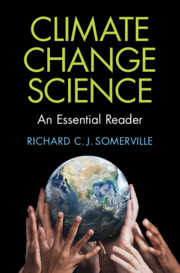
-
Select format
-
- Publisher:
- Cambridge University Press
- Publication date:
- 13 November 2025
- 20 November 2025
- ISBN:
- 9781009691147
- 9781009691185
- 9781009691154
- Dimensions:
- (229 x 152 mm)
- Weight & Pages:
- 0.447kg, 204 Pages
- Dimensions:
- (229 x 152 mm)
- Weight & Pages:
- 0.303kg, 204 Pages
You may already have access via personal or institutional login
Book description
Written by an established climate change scientist, this book introduces readers to cutting-edge climate change science. Unlike many books on the topic that devote themselves to recent events, this volume provides a historical context and describes early research results as well as key modern scientific findings. It explains how the climate change issue has developed over many decades, how the science has progressed, how diplomacy has (so far) proven unable to find a means of limiting global emissions of heat-trapping substances, and how the forecast for future climate change has become more worrisome. A scientific or mathematical background is not necessary to read this book, which includes no equations, jargon, complex charts or graphs, or quantitative science at all. Anyone who can read a newspaper will understand this book. It is ideal for introductory courses on climate change, especially for non-science major students.
Reviews
‘This succinct collection distils the insights of one of the world’s foremost climate scientists. Clear, engaging, and deeply informative, Climate Change Science is an illuminating guide for readers seeking clarity-and a much-needed response to the ongoing assault on climate science.’
Kerry A. Emanuel - Massachusetts Institute of Technology
‘At a time when misinformation and disinformation are polluting the discourse related to climate change, Somerville’s book is a beacon of sound science written in an accessible manner. The ‘So-What’s?’ are clear.’
Marshall Shepherd - University of Georgia
‘Richard Somerville’s Climate Change Science: An Essential Reader provides a masterclass in climate change communication, delivered by someone who has spent decades working in the field. The book is excellently written, thought-provoking and informative. A highly enjoyable read that does not require you to have a background in mathematics or science before you start.’
Matt Smith - University of Worcester
‘Designed for readers with little science or math background, Somerville gracefully illuminates the elements of climate science. Students will enjoy reading this book, and they will talk about it with their friends.’
Valerie Thomas - Georgia Institute of Technology
‘In Climate Change Science, Dr. Richard Somerville, a prominent climate scientist, recounts the history of climate change research while clearly explaining the fundamental science behind this urgent issue facing humanity. Throughout the book, Dr. Somerville weaves together history and anecdotes to make the complex science accessible … Reading this book is like listening to a lecture given by Dr. Somerville himself-his voice comes through in every chapter, adding a personal perspective … His explanations are clear, inviting readers from all backgrounds to engage with this critical topic…By writing this book in a way that is accessible to anyone … he is inviting everyone to the table to join the discussion and work toward solutions for the impending climate crisis. Climate Change Science is ideal for seminar-style classes in the social sciences, or as an introductory text in the sciences.’
Tamara Barriquand - Humboldt University
Contents
Metrics
Altmetric attention score
Full text views
Full text views help Loading metrics...
Loading metrics...
* Views captured on Cambridge Core between #date#. This data will be updated every 24 hours.
Usage data cannot currently be displayed.
Accessibility standard: WCAG 2.0 A
Why this information is here
This section outlines the accessibility features of this content - including support for screen readers, full keyboard navigation and high-contrast display options. This may not be relevant for you.
Accessibility Information
The PDF of this book conforms to version 2.0 of the Web Content Accessibility Guidelines (WCAG), ensuring core accessibility principles are addressed and meets the basic (A) level of WCAG compliance, addressing essential accessibility barriers.
Content Navigation
Table of contents navigation
Allows you to navigate directly to chapters, sections, or non‐text items through a linked table of contents, reducing the need for extensive scrolling.
Index navigation
Provides an interactive index, letting you go straight to where a term or subject appears in the text without manual searching.
Reading Order and Textual Equivalents
Single logical reading order
You will encounter all content (including footnotes, captions, etc.) in a clear, sequential flow, making it easier to follow with assistive tools like screen readers.
Short alternative textual descriptions
You get concise descriptions (for images, charts, or media clips), ensuring you do not miss crucial information when visual or audio elements are not accessible.
Structural and Technical Features
ARIA roles provided
You gain clarity from ARIA (Accessible Rich Internet Applications) roles and attributes, as they help assistive technologies interpret how each part of the content functions.

